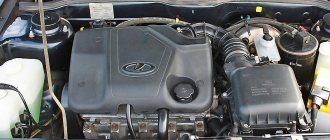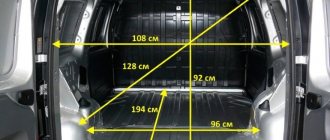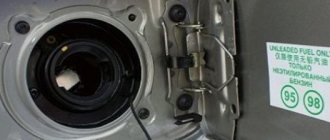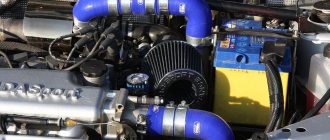Gasoline consumption for Priora I Restyling sedans
| Engine, gearbox | Petrol | Consumption in the city | Along the highway | Mixed | Cost of 1000 km of gasoline in the city |
| 1.6MT | AI-95 | 8,9 | 5,6 | 6,8 | RUB 4,183 |
| 1.6 AMT | AI-95 | 8,5 | 5,5 | 6,6 | RUB 3,995 |
| 1.8MT | AI-95 | 9,2 | 5,4 | 7,2 | RUB 4,324 |
| Gasoline consumption in liters per 100 km. Price per liter of gasoline in calculations: AI-95 - 47.00 rubles. | |||||
Propane consumption for Priora sedans, savings
| Engine | Gas type | Propane consumption modes | Fuel cost per 1000 km in city mode | ||||
| City | Route | Mixed | Petrol | Propane | Saving | ||
| 1.6MT | CIS | 9,8 | 6,2 | 7,5 | RUB 4,183 | RUB 2,156 | |
| 1.6 AMT | CIS | 9,4 | 6,1 | 7,3 | RUB 3,995 | RUB 2,068 | |
| 1.8MT | CIS | 10,1 | 5,9 | 7,9 | RUB 4,324 | RUB 2,222 | |
| LPG - liquefied petroleum gas (a mixture of propane and butane). Price per liter of propane in calculations: CIS - 22.00 rub. | |||||||
Methane and Priora. Methane equipment is not compatible with some engines.
Check the technical feasibility of installing methane on your LADA Priora sedan with the manager: - around the clock. On average, methane consumption in the city is close to gasoline consumption. On the highway, consumption is 15-20% slower. Methane is cheaper than propane by one and a half rubles per liter.
VAZ 2170 Lada Priora technical specifications
PERFORMANCE INDICATORS of VAZ 2170 Lada Priora
Maximum speed: 183 km/h Acceleration time to 100 km/h: 11.5 sec Fuel consumption per 100 km in the city: 9.8 l Fuel consumption per 100 km on the highway: 5.6 l Fuel consumption per 100 km in the combined cycle: 7.2 l Fuel tank volume: 43 l Vehicle curb weight: 1095 kg Tire size: 185/65 R14
ENGINE CHARACTERISTICS
Location: front, transverse Engine volume: 1596 cm3 Power: 98 hp Number of revolutions: 5600 Torque: 145/4000 N*m Power system: Distributed injection Turbocharging: no Gas distribution mechanism: Not included Cylinder arrangement: In-line Number of cylinders: 4 Number of valves per cylinder: 4 Recommended fuel: AI-95 Environmental standard: EURO III
BRAKE SYSTEM
Front brakes: Disc Rear brakes: Drum
STEERING
Steering type: Rack and pinion Power steering: Electric power steering
TRANSMISSION
Drive: Front Number of gears: manual – 5
SUSPENSION
Front suspension: Coil spring Rear suspension: Anti-roll bar
BODY
Body type: Sedan Number of doors: 4 Number of seats: 5 Vehicle length: 4350 mm Vehicle width: 1680 mm Vehicle height: 1420 mm Wheelbase: 2492 mm Front track: 1410 mm Rear track: 1380 mm Trunk volume: 430 l
PRODUCTION
Year of manufacture: since 2007
How to pass your license the first time
Categories
- Selecting and purchasing a car 3330
- Traffic police and traffic rules316
- Engine and components2754
- Auto630 history
- Body101
- Engine oil1096
- Suspension24
- Breakdowns and repairs2823
- Cooling system245
- Insurance and lending60
- Brake system61
- Gear oil656
- Tuning287
- Characteristics1394
- Tires and wheels2473
- Operation and Maintenance3739
- Electrical equipment198
Archive of articles and useful information
Ask your question
Did not find an answer to your question? Ask it to auto experts!
Reply within 10 minutes
Ask a Question
Stamps
- Acura
- Alfa Romeo
- Audi
- BMW
- Cadillac
- Changan
- Chery
- Chevrolet
- Chrysler
- Citroën
- Daewoo
- Datsun
- Dodge
- Fiat
- Ford
- Geely
- Great Wall
- Haval
- Honda
- Hummer
- Hyundai
- Infiniti
- Jaguar
- Jeep
- KIA
- Land Rover
- Lexus
- Lifan
- Mazda
- Mercedes-Benz
- MINI
- Mitsubishi
- Nissan
- Opel
- Peugeot
- Porsche
- Ravon
- Renault
- Saab
- Seat
- Skoda
- SsangYong
- Subaru
- Suzuki
- Toyota
- Volkswagen
- Volvo
- Vortex
- VAZ
- GAS
- ZAZ
- ZIL
- KamAZ
- Moskvich
- TagAZ
- UAZ
How to remove and install a fuel tank yourself
In order to replace a faulty tank on a LADA Priora you will need the appropriate set of tools:
- Pliers.
- Wrenches included in the set.
- Screwdrivers, both Phillips and flathead.
- Heads included.
Ground clearance Lada Vesta
Crash test Lada Vesta
Fog lights Lada Vesta
Step-by-step instructions for replacing the fuel tank on a Priora with your own hands:
- The fuel tank of the Lada Priora should contain as little fuel as possible. Therefore, it is better to first use as many liters of fuel as are left in the car.
- The car will have to be driven onto an overpass, or, if desired, into a pit.
- At this stage, you have to remove the rear sofa and fold back the carpet, under which the fuel pump cover is actually located.
- The cover is secured with a pair of screws, which must be unscrewed and the cover removed. You will see a device called a fuel pump.
- The wire block can be disconnected by bending the special clamp.
- We start the engine and wait until it stalls.
- Let's compare the pressure. This is done with the help of a starter, which needs to be turned for 3 seconds.
- Remove the “-” terminal from the battery.
- Squeezing the plastic clamp, disconnect the fuel pump tube from the fitting.
- We do the same with the second fitting.
- Now you should loosen the clamp of the air outlet hose and remove it from the pipe.
- We remove the tube that is responsible for draining the fuel from the special compartment of the separator. This can be done by clamping the latches on the sides.
- We also disconnect the hose going from the filler pipe to the tank nozzle.
- Remove the 2 clamps holding the gas tank.
- If you need to completely replace the tank, you will need to change all the supply hoses without exception. Don't forget to remove the air outlet hose from the tank fitting.
- Return to the place where you removed the cover under the rear seats. Make sure that the nut securing the “-” is removed.
- We remove the wire.
- Remove the pressure ring; for this purpose you need to remove 7 nuts.
- We remove the pump very carefully; when removing it, you need to tilt it slightly to the side so as not to damage the fuel sensor.
- There is a rubber O-ring on the gas tank flange. It needs to be replaced because it becomes cracked over time.
- The neck plug through which fuel is poured into the pipe must be removed, after which we remove the lower bracket on which it is supported. It is important to remove the top bracket only after this.
- We remove the upper end from the filling pipe, or rather from its facing part, then remove the pipe. After this we remove the facing part. You can put the elastic back if it is not damaged.
- Remove the hose from the filler neck.
- After everything has been removed carefully and in the correct order, you can install a new unit, and if necessary, replace all seals, gaskets and hoses that are damaged, even if they are minor. Correct work will ensure stable operation of the fuel sensor and fuel pump.
New Lada: Exclusive tuning of Lada Priora with automatic transmission, big project
How far can you travel?
The volume of the Priora's fuel tank is designed so that the car can travel a certain distance without refueling. In many ways, the power reserve is individual – that is, it depends on the driver’s driving style. Sharp acceleration increases fuel consumption, and the same thing happens if you select the wrong gear. But there is not only a human factor. Firstly, different amounts of fuel are consumed in the city, on the highway and in the combined cycle when recalculated per 100 km.
Secondly, a lot depends on the engine: the Priora was equipped with engines with a displacement of 1.6 liters with eight and sixteen valves and a power of 81, 87, 98 and 106 hp. Plus, since 2013, after restyling, the Priora was equipped with a robotic automatic transmission. The most popular choice is a sixteen-valve engine with 98 hp. along with manual transmission. Calculations will be given for it.
On a full tank
So, the configuration we have chosen consumes:
- 9.8 l per 100 km in the city;
- 5.6 l per 100 km on the highway;
- 7.2 liters per 100 km in the combined cycle.
With the maximum filling of the gas tank, the Lada Priora, powered by AI-95 (according to the passport!) will travel:
- 438.77 km in the city;
- 767.88 km on the highway;
- 597.22 km combined cycle.
It is worth subtracting at least 30 km from these figures so as not to kill the fuel pump - if it pumps air and debris from the bottom of the gas tank, its service life will gradually come to an end.
Lada Priora 2007, sedan
03.2007 — 07.2020
| Options | Fuel tank volume, l |
| 1.6 MT Standard0 | 43 |
| 1.6 MT Standard0 | 43 |
| 1.6 MT Norma9 | 43 |
| 1.6 MT Norma9 | 43 |
| 1.6 MT Norma5 | 43 |
| 1.6 MT Norma3 | 43 |
| 1.6 MT Norma5 | 43 |
| 1.6 MT Norma5 | 43 |
| 1.6 MT Norma2 | 43 |
| 1.6 MT Norma1 | 43 |
| 1.6 MT Norma2 | 43 |
| 1.6 MT Norma1 | 43 |
| 1.6 MT Norma8/029 | 43 |
| 1.6 MT Norma0 | 43 |
| 1.6 MT Norma9 | 43 |
| 1.6 MT Lux0 | 43 |
| 1.6 MT Lux8/019 | 43 |
| 1.6 MT Lux9 | 43 |
| 1.6 MT Lux2 | 43 |
| 1.6 MT Lux9 | 43 |
| 1.6 MT Lux3 | 43 |
| 1.6 MT Lux1 | 43 |
| 1.6 MT Lux1 | 43 |
| 1.6 MT Lux3 | 43 |
| 1.6 MT Lux9 | 43 |
| 1.6 MT Norma1 | 43 |
| 1.6 MT Norma7 | 43 |
| 1.6 MT Norma9 | 43 |
| 1.6 MT Norma2 | 43 |
| 1.6 MT Lux1 | 43 |
| 1.6 MT Norma1 | 43 |
| 1.6 MT Norma3 | 43 |
| 1.6 MT Norma5 | 43 |
| 1.6 MT Norma7 | 43 |
| 1.6 MT Lux1 | 43 |
| 1.6 MT Lux3 | 43 |
| 1.6 MT Lux9 | 43 |
| 1.6 MT Lux1 | 43 |
| 1.6 MT Lux6 | 43 |
| 1.6 MT Lux6 | 43 |
Malfunction of the adsorber and adsorber valve on a Priora: main symptoms
The fundamental element of the entire system is the solenoid valve, which is controlled by the ECU. It is because of the failure of this element that problems arise on the car. However, let’s look at the main signs of a malfunction of the gasoline vapor recovery system:
- Floating speed. Naturally, there is no need to rush to diagnose the system, since this phenomenon is often associated with a number of other problems, but it should not be ruled out either. Why do the revs fluctuate? The cause is a solenoid valve that may be stuck open. As a result, it turns out that air is sucked into the throttle assembly when starting the engine, which ultimately leads to the appearance of the effect of changing crankshaft speeds. Prior owners often encounter this problem, so it is important to pay attention to the serviceability of the solenoid valve. You will find out where it is located on Priora and how to check it in the sections below.
- The engine does not gain full power, which is quite understandable; an element of the fuel vapor recovery system is faulty. As a rule, this can be caused by clogged adsorber, which reduces throughput.
- The engine stalls at idle when trying to add gas.
- Fuel indication sensor readings are incorrect. It shows either a full tank or an empty one. This usually happens when the pressure relief valve does not cope with its function. The possibility of failure of the gas tank cap, which has a built-in breather, cannot be ruled out.
- Increased fuel consumption.
- When you unscrew the cap from the neck of the tank, a long hissing sound occurs, indicating that the pressure valve is not coping with the task (the pressure is not equalized). If hissing does not occur at all when unscrewing the lid, then this may also be a sign of a malfunction of the breather in the lid, since depressurization of the product is appropriate.
These signs indicate that there is a malfunction in the gasoline vapor recovery system on the Priora. In addition, if the solenoid valve (purge) fails, the Check Engine may light up on the instrument panel, and the corresponding error codes will be displayed on the on-board computer:
- P0441 - incorrect air flow through the adsorber valve;
- P0442 - leak in the gasoline vapor recovery system;
- P0443 - malfunction of the valve circuit of the gasoline vapor recovery system;
- P0444 - break in the canister valve wire;
- P0445 - the control circuit for the canister purge valve closes to ground;
- P0446 - malfunction of the control circuit of the vapor valve for collecting gasoline vapors EVAP (Evaporative Emission Control System Vent Control Circuit Malfunction).
If one of the errors listed above is displayed on the BC, then you need to look for a malfunction in the gasoline vapor recovery system. Typically, this error can be associated with a failed solenoid valve, a clogged filter element, or a faulty pressure relief valve.
Lada Priora 2008, station wagon
10.2008 — 09.2020
| Options | Fuel tank volume, l |
| Norm | 43 |
| Lux | 43 |
| Lux | 43 |
| Lux | 43 |
| Lux | 43 |
| Norma9 | 43 |
| Norma3 | 43 |
| Lux9 | 43 |
| Lux9 | 43 |
| Norma5 | 43 |
| Lux0 | 43 |
| Lux8 | 43 |
| Norma5 | 43 |
| Norma9 | 43 |
| Norma8/029 | 43 |
| Norm1 | 43 |
| Norma2 | 43 |
| Norma2 | 43 |
| Lux2 | 43 |
| Lux9 | 43 |
| Lux3 | 43 |
| Norma9 | 43 |
| Norma7 | 43 |
| Norma5 | 43 |
| Norm1 | 43 |
| Norma3 | 43 |
| Lux1 | 43 |
| Lux1 | 43 |
| Norma5 | 43 |
| Norm1 | 43 |
| Norma3 | 43 |
| Norma7 | 43 |
| Lux1 | 43 |
| Lux3 | 43 |
| Lux9 | 43 |
| Lux1 | 43 |
| Lux6 | 43 |
| Lux6 | 43 |
New Lada: LADA Priora for Spin Tires
Instructions for checking and replacing the adsorber valve on a Priora: where it is located, cleaning, article number
A headache on VAZ cars is the solenoid valve or the adsorber purge valve. Let's look at this device in more detail. First, let's find out where it is located on Priora. The photo below shows the location of the canister purge valve on a Priora.
It is located near the right “glass”. The material repeatedly mentioned why the canister purge valve on a car is needed and what function it performs. Below is another reminder of what the part is for.
First, let's understand the principle of operation of the valve. The electrical diagram of the canister purge valve on the Priora along with the pinout will help with this.
The device is a valve that is controlled by electrical impulses. To do this, the design of the device has a winding, which, when power is applied, retracts the metal core, which leads to the opening of a channel through which air passes from the adsorber to the throttle assembly. The part is non-separable and non-repairable, therefore, if there are signs of malfunction, it should be replaced. Below in the photo is the canister purge valve (from Kalina) in cut form.
The device receives two contacts: one from the relay (plus), and the second control from the ECU (ground). The valve opens when a voltage pulse is supplied from the ECU. The operating principle of this device is simple. However, despite this, on all VAZ cars, the canister purge valve is a common cause of floating speed, a decrease in engine power and an increase in fuel consumption. This happens due to the fact that activated carbon granules from the adsorber get into the channel with the valve, which ultimately leads to the device jamming in the open position. After starting the engine, the valve should be closed, but since it jams, it remains open, so air leaks into the throttle assembly at idle.
To check the functionality of the solenoid valve, you need to perform the following steps:
- First you need to remove the device from the car. To do this, you need to disconnect the power supply and loosen the clamps (if any) that secure the hoses. After this, remove the part by pressing the latch and pulling it up. Often the latch fails, so you can use a plastic clamp.
- Carry out an inspection. After inspection, you can draw conclusions about the serviceability of the product, as evidenced by the photo below.
- Now let's proceed to the actual verification. Using a bulb, syringe or compressor, we supply air into one of the channels. Air should not escape from the second, since when the power is turned off, the valve closes. If it is blown through, then there is a high probability of it getting stuck in the open position.
- Another way to check is to apply 12V power to the contacts of the device. In this case, a characteristic click will be heard, indicating that the valve has been activated (its opening). We stop the power supply, and at the same time it should click again, which indicates that it is closed and serviceable.
- Don't forget to make sure that the valve is receiving power. To do this, we measure it in the chip using a multimeter. The voltage should be 12V. Contact “A” is positive, and “B” is “ground” from the ECU.
The verification procedure is not at all complicated and takes about 10 minutes. Based on the results, a decision is made about the need to replace the valve. If it is not working, then it must be replaced. We buy a new device, which has the code 21103-1164200-02/21103-1164200-03 (the products are interchangeable).
If the malfunction occurs on the road, then you can try to clean the valve if it is jammed due to clogging of the channel with activated carbon. To do this, you need to remove the valve and clean the channel with carburetor cleaner or WD-40. In this case, we definitely gain access to the adjusting screw, which is filled with compound. We unscrew the screw (remember the number of turns so that we can screw it back to the same value, otherwise there will be suction), and clean it.
We repeat the procedure several times, and if there is a compressor, we blow the channel with compressed air to remove contaminants from it. When assembling, be sure to fill the location of the adjusting screw with sealant to prevent suction.
If it is possible to restore the functionality of the device, then it will still serve for some time. However, you should not delay replacing it, as liquids that get inside can lead to winding failure.
And in conclusion, it is worth noting that the optimal way to prevent the adsorber purge valve from becoming clogged with activated carbon is to install a filter at its inlet. A regular gasoline or gas filter is suitable for this, as shown in the photo above.
This is interesting! A valve malfunction may manifest itself as a clicking sound after starting the engine. In this case, the part must also be replaced.
Lada Priora 2008, hatchback
02.2008 — 08.2020
| Options | Fuel tank volume, l |
| 1.6 MT Standard0 | 43 |
| 1.6 MT Standard0 | 43 |
| 1.6 MT Norma5 | 43 |
| 1.6 MT Norma8/029 | 43 |
| 1.6 MT Norma1 | 43 |
| 1.6 MT Norma1 | 43 |
| 1.6 MT Norma2 | 43 |
| 1.6 MT Norma9 | 43 |
| 1.6 MT Norma9 | 43 |
| 1.6 MT Norma5 | 43 |
| 1.6 MT Norma3 | 43 |
| 1.6 MT Norma9 | 43 |
| 1.6 MT Norma5 | 43 |
| 1.6 MT Lux1 | 43 |
| 1.6 MT Lux1 | 43 |
| 1.6 MT Lux3 | 43 |
| 1.6 MT Lux3 | 43 |
| 1.6 MT Lux9 | 43 |
| 1.6 MT Lux9 | 43 |
| 1.6 MT Lux9 | 43 |
| 1.6 MT Lux8 | 43 |
| 1.6 MT Lux0 | 43 |
| 1.6 MT Norma1 | 43 |
| 1.6 MT Norma5 | 43 |
| 1.6 MT Norma7 | 43 |
| 1.6 MT Norma2 | 43 |
| 1.6 MT Lux2 | 43 |
| 1.6 MT Lux9 | 43 |
| 1.6 MT Lux1 | 43 |
| 1.6 MT Norma1 | 43 |
| 1.6 MT Norma3 | 43 |
| 1.6 MT Norma5 | 43 |
| 1.6 MT Norma7 | 43 |
| 1.6 MT Lux1 | 43 |
| 1.6 MT Lux3 | 43 |
| 1.6 MT Lux9 | 43 |
| 1.6 MT Lux1 | 43 |
| 1.6 MT Lux6 | 43 |
| 1.6 MT Lux6 | 43 |
Lada Priora restyling 2021, sedan
10.2020 — 07.2020
| Options | Fuel tank volume, l |
| Lux3 | 43 |
| Norma5 | 43 |
| Norma7 | 43 |
| Norma5 | 43 |
| Lux1 | 43 |
| Lux1 | 43 |
| Lux5 | 43 |
| Lux7 | 43 |
| Norma5 | 43 |
| Norm Climate7 | 43 |
| Norma White Edition7 | 43 |
| Norma Black Edition7 | 43 |
| Norm Climate8 | 43 |
| Comfort8 | 43 |
| Image8 | 43 |
| Lux3 | 43 |
| Norma9 | 43 |
| Lux6 | 43 |
| Norma8 | 43 |
| Standard0 | 43 |
| Standard0 | 43 |
| Norma3 | 43 |
| Norma4 | 43 |
| Norma5 | 43 |
| Norma9 | 43 |
| Norma7 | 43 |
| Lux6 | 43 |
| Norma4 | 43 |
| Norma7 | 43 |
| Norma4 | 43 |
New Lada: Lada Priora for sale in Irkutsk
Automotive gasoline vapor trap: adsorber and its purpose
You should immediately understand the question of what an adsorber is and why it is needed on a car. Initially, it is worth noting that the correct name of this device is an adsorber, that is, it is written with the letter “d,” although many call it an absorber, which is not entirely correct. The difference between an adsorber and an absorber is that the first one accumulates vapors (in this case, gasoline) and holds them, while the second one completely absorbs the substance (that is, with the impossibility of their subsequent release).
We will find out why cars use an adsorber and not an absorber after understanding the purpose of this device.
A gasoline vapor collector is a kind of filter that prevents direct contact of gasoline with the atmosphere, which reduces the level of pollution. Such devices were invented after the introduction of the Euro-2 environmental standard, which prohibits atmospheric pollution with gasoline vapors.
The main purpose of the device is to temporarily absorb the vapors that form in the gas tank and use them for selfish purposes, that is, not just suppress, but transport them to the engine, where they will be supplied to the cylinders for combustion along with the fuel assembly.
Returning to the name of the device, we can safely say that the Priora and other modern cars use an adsorber that only temporarily accumulates gasoline vapor (which occurs while the engine is not running). The use of absorbers would not allow vapors to be directed into the combustion chambers of the engine due to their complete absorption by the sorbent.
This is interesting! Activated carbon is used as a sorbent in automobile adsorbers.
Lada Priora restyling 2021, station wagon
10.2020 — 12.2020
| Options | Fuel tank volume, l |
| Lux3 | 43 |
| Norma5 | 43 |
| Norma7 | 43 |
| Norma5 | 43 |
| Lux1 | 43 |
| Lux3 | 43 |
| Lux6 | 43 |
| Norma9 | 43 |
| Norma4 | 43 |
| Norma5 | 43 |
| Norma7 | 43 |
| Lux6 | 43 |
| Norma4 | 43 |
| Norma7 | 43 |
| Norma4 | 43 |
Diagram of the fuel vapor recovery system on Priora: design and designation of the main elements
The diagram of the gasoline vapor recovery system on Priora is as follows:
Fuel vapor recovery system VAZ-2170
In the diagram, each element has a corresponding name and purpose. The name of each item is listed in the description below:
The purpose of each element of the system is described in detail in the material below.
This is interesting! The vent tube numbered “9” is designed to remove air from the tank as it fills with fuel.
Lada Priora restyling 2021, hatchback
10.2020 — 12.2020
| Options | Fuel tank volume, l |
| Lux3 | 43 |
| Norma5 | 43 |
| Norma7 | 43 |
| Norma5 | 43 |
| Lux1 | 43 |
| Lux3 | 43 |
| Norma9 | 43 |
| Lux6 | 43 |
| Norma3 | 43 |
| Norma4 | 43 |
| Norma5 | 43 |
| Norma7 | 43 |
| Norma9 | 43 |
| Lux6 | 43 |
| Norma4 | 43 |
| Norma7 | 43 |
| Norma4 | 43 |
How does a car's gasoline vapor recovery system (adsorber) work?
The principle of its operation on Priora is identical to other brands of cars, so let’s look at the overall picture.
- Gasoline has the property of releasing vapors, which usually accumulate in the upper part of the filler neck of the tank. For this, a separator is used, with the help of which these vapors are condensed and returned in liquid form back to the tank.
- Some vapors do not condense in the separator, so an adsorber is provided for this. In it, vapors accumulate and are retained (this happens when the car engine is turned off).
- After starting the engine, reaching operating temperature, and only with the throttle valve open (this is very important), the solenoid valve opens. When it is triggered, for which the ECU is responsible, gasoline vapor is supplied from the adsorber to the throttle assembly. This process is called purging. Its duration is controlled by the ECU.
- The process occurs as follows: the adsorber has a channel connecting it to the environment. As soon as the solenoid valve opens, the engine sucks in air, which, together with gasoline vapor from the adsorber, enters the throttle assembly.
- From the throttle, these vapors, along with the air, enter the intake manifold, where they are mixed with a portion of gasoline released from the injectors and are sucked into the combustion chambers of the cylinders. As a result, they are burned, thereby increasing the efficiency of the internal combustion engine.
The operating principle of the system is quite simple and reliable, but malfunctions occur, which leads to problems with engine operation. What are the signs of a malfunction of the adsorber and its valve on a Priora, and how to determine the failure of parts of this system, we will consider further.
How long does a full tank last in a Priora?
Like any other car, the Lada Priora in a sedan body, and even in a station wagon body, and accordingly a hatchback, has a certain gas tank capacity. How long you can drive if your car's tank is full depends greatly on where you're driving (in the city or on the highway), as well as on your driving style.
Not everything depends on the human factor; how many liters of fuel will be consumed while driving is also influenced by the cost of the power unit. LADA Priora is equipped with a 1.6 liter engine. with 8 and 16 valves, power 81l/str, 87l/str, 98l/str, and even 106l/str. Plus, after restyling in 2021, the car began to be equipped with a robotic gearbox.
Initial characteristics
Car manufacturers always indicate the technical characteristics of their products with some errors. And Priora, produced by the automobile company AvtoVAZ, is perhaps no exception. Initial data for this car included gasoline consumption of 6.8 to 7.3 liters/100 km.
But the real data of this model fluctuate a little and not even in the smallest amounts. And the consumption rates for such a Lada per 100 km are already different. Now we will try to show it to you.
| Engine | Consumption (highway) | Consumption (city) | Consumption (mixed cycle) |
| 1.6i 98 hp 5-mech | 5.5 l/100 km | 9.1 l/100 km | 6.9 l/100 km |
| 1.6i 106 hp 5-mech | 5.6 l/100 km | 8.9 l/100 km | 6.8 l/100 km |
| 1.6i 106 hp 5-rob | 5.5 l/100 km | 8.5 l/100 km | 6.6 l/100 km |











